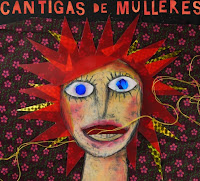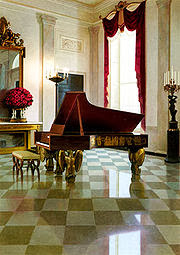In review--Galician Ladies Sing Out
World
Cantigas de
Mulleres (Songs of Women)
(Compilation of
Galician Songs)Folmusica
I’ve acquired a small collection of Galician recordings
mostly featuring jazz and folkloric music.
The latest CD to come my way is a compilation, Cantigas De Mulleres featuring Galician women musicians such as
bigger names Uxía, Cristina Pato, Gaudi Galego and Ugía Pedreira and upcoming
talent such as 16-year old Sonia Lebedinsky whose mature vocals defies her
youth and a musical elder Señora Carmen, age 86. While the musicians focus on folkloric songs,
the treatment of the songs range from medieval DOA’s Levousa Fremousa (which you can find a
video on YouTube) to Celtic pipes (Susana Seivane’s Xoaniã) to ultra-modern (Mercedes Peón’s Derorán).
Marful (Ugiá Pedreira) brings in a warm jazzy element
mixed with folkloric elements on the song Tris
Tras. Whereas, SOAS (Cristina Pato
and Rosa Cedrón) brings in Celtic piano, lush strings and aching vocals. Leilía (a group of 6 percussionists-singers)
shows a more rousing side of Galician music, as does the women’s collective
Malvela on the track, Pola Rua de San Pedro.
Slowing it down, the group Sés performs Fala de Mel with solo vocals and acoustic guitar. It’s the closest
the album comes to a singer-songwriter track.
I have enjoyed listening to the acoustic folk or jazz songs and I find the electronic tracks distracting, though I can understand how these songs
might reach younger audiences and people searching for the “cool” or hip
factor. I’m just not among that crowd
and I prefer folkloric songs performed on original instruments or at least
acoustic ones. Otherwise, I hit the skip
button.
This brings up a question that has been scratching my
brain lately. For music audiences
outside of a tradition or culture, how do we know which part of the music
production comes from the tradition and which part is hybrid? How do music
journalists decipher the traditional elements of the music from the more modern
sound if we had not heard the traditional music in a pure form? And how can we
preserve music traditions if we water them down with other influences?
Granted, musicians have been exchanging songs and musical
instruments from the beginning and it is doubtful that the ancient Greeks did not
trade musical ideas with ancient Egyptians.
Then there’s the Silk Road to consider where musical ideas were
exchanged along the routes. So in 2013
let these questions guide us on the quest for music preservation. What exactly are we preserving? And is there
any culture on the planet not influenced by another one? Musical exchange is healthy, in my opinion,
but I think we need to be careful when using the word “traditional” especially
when many of the traditions (such as types of work, festivities, and lifestyles) behind certain music were lost between the
industrial and technological ages.




Comments
Post a Comment